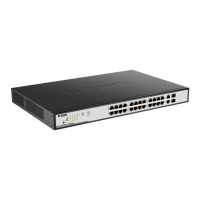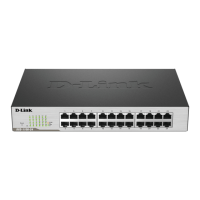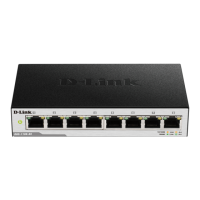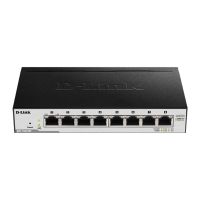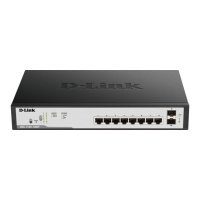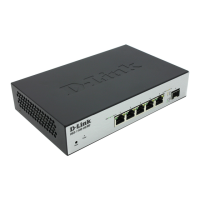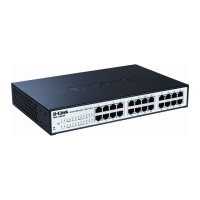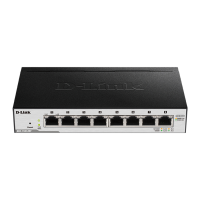Do you have a question about the D-Link DGS-1100-26 and is the answer not in the manual?
Defines the intended audience for the manual, focusing on network administrators and IT professionals.
Lists additional resources and documents available for configuring and troubleshooting the switch.
Explains the typographical conventions used in the manual for clarity and consistency.
Highlights important information, potential hardware damage, or safety warnings within the manual.
Details the 16-port 10/100/1000Mbps switch, including front and rear panel layouts.
Details the 16-port 10/100/1000Mbps + 2 SFP port switch, including front and rear panel layouts.
Details the 24-port 10/100/1000Mbps switch, including front and rear panel layouts.
Details the 24-port 10/100/1000Mbps PoE switch, including front and rear panel layouts.
Details the 24-port 10/100/1000Mbps + 2 SFP port switch, including front and rear panel layouts.
Provides instructions for unpacking the switch and verifying the contents of the package.
Offers guidance on safe installation practices, including desktop/shelf and rack mounting.
Details the procedure for connecting the switch to a power source.
Explains the steps required to properly ground the switch for safety and protection.
Outlines the different platforms available for configuring, managing, and monitoring the switch.
Describes the necessary equipment and steps to connect to the switch via its web interface.
Guides users on how to access the switch's web management interface using its default IP address.
Details the initial setup wizard that guides users through basic configuration steps.
Provides an overview of the main web interface layout and its key areas.
Displays detailed information about the switch's hardware, firmware, and network status.
Allows configuration of system name, location, and contact details for switch identification.
Covers the configuration of IPv4 settings, including IP address assignment methods.
Details the configuration options for IPv6 functionality on the switch.
Enables the configuration of individual port settings, including speed, duplex, and jumbo frames.
Explains Power over Ethernet features, system settings, status, and port configuration.
Covers system log settings, server configurations, and viewing log entries.
Details clock settings, time zone configuration, SNTP synchronization, and time profiles.
Allows creation and management of user accounts with different privilege levels.
Covers SNMP settings, including global configuration, community tables, and host settings.
Configures web access settings, enabling HTTP or HTTPS for switch management.
Enables or disables the D-Link Discovery Protocol (DDP) for network device discovery.
Manages the Forwarding Database (FDB), including static unicast and multicast entries.
Covers VLAN configuration including 802.1Q, port-based, management, asymmetric, and interface settings.
Details Spanning Tree Protocol (STP) configurations, including global and port settings.
Configures loopback detection to identify and mitigate network loops.
Explains port trunking and link aggregation for increasing bandwidth and redundancy.
Manages Layer 2 multicast features, including IGMP snooping and multicast filtering.
Configures Link Layer Discovery Protocol (LLDP) for advertising and learning neighbor information.
Configures port scheduler methods and default Class of Service (CoS) settings.
Sets ingress and egress rate limits for ports to control bandwidth usage.
Enables or disables the Safeguard Engine to protect against packet flooding.
Configures traffic segmentation to restrict Layer 2 forwarding within specified domains.
Sets parameters to detect and mitigate broadcast, multicast, and unicast storm attacks.
Configures settings to prevent various types of Denial-of-Service (DoS) attacks.
Enables or disables the Zone Defense feature for network security.
Manages Secure Sockets Layer (SSL) settings for secure communication.
Tests copper cables to verify quality and identify errors.
Displays port counter statistics, including transmitted and received packets.
Configures port mirroring to copy traffic to a monitoring device.
Configures power saving features like link detection, scheduled shutdown, and LED dimming.
Enables or disables Energy Efficient Ethernet (EEE) to reduce power consumption.
Saves the current running configuration to the switch's flash memory.
Manages firmware upgrades and backups via HTTP or TFTP.
Restores or backs up switch configuration files via HTTP or TFTP.
Performs system log backups to local PC or TFTP server.
Tests network connectivity by sending ICMP Echo requests to specified IP addresses.
Resets the switch configuration to factory default settings.
Reboots the switch, with options to save current configuration changes.
Provides background on Gigabit Ethernet, its speed, and benefits for network upgrades.
Describes Fast Ethernet (100BASE-T) as an evolution of 10Mbps Ethernet for higher performance.
Explains how switching technology increases network capacity by segmenting LANs.
Lists key hardware components, performance metrics, and memory details.
Details operating conditions, temperature, and humidity requirements.
Lists electromagnetic interference certifications such as FCC, CE, and VCCI.
Specifies safety certifications including CUL, LVD, CB, and BSMI.
| Switching Capacity | 52 Gbps |
|---|---|
| Forwarding Rate | 38.7 Mpps |
| MAC Address Table Size | 8K entries |
| Dimensions | 440 x 180 x 44 mm |
| Switch Type | Unmanaged |
| Packet Buffer Memory | 512 KB |
| Jumbo Frame | 9, 216 Bytes |
| Power Supply | Internal power supply |
| Operating Temperature | 0 to 45 °C (32 to 113 °F) |
| Management | Web-based |
| Storage Temperature | -40 to 70 °C (-40 to 158 °F) |
| Humidity | 0% to 95% (non-condensing) |
| Certifications | CE, FCC |

